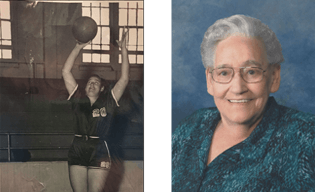Flying Queen
1952-56
Lometa Odom, Flying Queen extraordinaire from 1952-56, died on Friday, Jan. 27, 2017, in Amarillo, Texas, at age 83. This is her story as chronicled by Leanne Waddell South, Flying Queen 1974-78 and Lometa’s sister, Margaret Odom Parks, Flying Queen 1955-59. The quotes in this story were taken from a Texas Monthly article by Skip Hollandsworth.
Lometa was the oldest of three daughters to Hiram and Opal Odom. All the Odom girls worked on a farm growing up and basketball was the center of their lives in school. Lometa spent much of her childhood in Bakersfield, Calif., but moved to Dimmitt when she was in the eighth grade. Lometa was always athletically minded and played nearly all the sports.
“I always played sports because there wasn’t anything else to do,” Odom said. “I played basketball and volleyball in high school. But I always used to play tag football in the wheat field with the boys. I always liked the rough stuff, even in basketball.”
In Bakersfield, Odom participated in some organized athletics. But she really developed her skills once she moved to Dimmitt. Her high school coach, John Blaine, taught her the fundamentals of the game, especially shooting.
“She could turn and go toward the basket and lay it up,” Mauriene Smithson Matthews, Odom’s teammate at Dimmitt and Wayland, said. “But most of all she could shoot. I mean she could really shoot.”
The 5-11 Odom helped Dimmitt win two mythical national championships in 1951 and 1952. In those years, Dimmitt, which had just won the Texas state title, played the state champion from Iowa for the national crown.
In high school, Odom and Ruth Cannon of Cotton Center staged some monumental duels. They respected each other’s game so much that they attended Wayland Baptist College together.
Lometa’s father, Hiram, wanted his daughters to attend college, and Wayland Baptist College was holding tryouts for their women’s basketball team.
“My daddy was determined to get me and my two sisters to college, but we didn’t have much money, and I figured at least one of us would end up driving a tractor on Daddy’s farm,” said Lometa. “So here was my chance. I was so nervous I could barely dribble the ball.”
When Wayland later sent Lometa a letter awarding her a scholarship, she and her parents hugged one another and tried not to cry. (“We were farm people,” she said. “We weren’t supposed to cry.”) She joined Ruth and her twin sister Ruby, and another set of twins, Faye and Raye Wilson, from Duncanville, just south of Dallas.
In high school, they had played under six-on-six half-court rules. Wayland played using AAU rules, which allowed two players from each team to freely move from one side to the other. At Wayland, Odom played what amounted to a four-on-four set.
She often was matched against taller inside players, like Barbara Ann Sipes, a 6-1, 200-pound post from Iowa Wesleyan College. Odom also remembered a 6-5 opponent who played for a club team called the Comets.
During her four-year career at Wayland, the Queens compiled a record of 115-5 and won three Amateur Athletic Union national championships. Lometa became the first Wayland Baptist player to earn four consecutive AAU All-America honors. She was named the 1956 AAU Tournament MVP and was part of the first 79 of the Flying Queens’ 131 consecutive wins during the 1950s.
In 1955 at Mexico City, Odom received her first taste of five-on-five basketball. She joined Flying Queens coach Caddo Matthews and five other Wayland teammates on the first women’s team the United States fielded at the Pan American Games.
Nearly all the players on that team had never tried five-on-five hoops, but the team rolled through the tournament field undefeated anyway and earned the gold medal.
The Pan Am team included Mauriene Smithson, Ruby and Ruth Cannon, Rita Alexander and Faye Wilson from Wayland.
“They built a huge gym with a lot of seats,” Odom said. “It was a huge place, and we got to see a lot of games. The tournament was great, except for the officiating.”
Odom came from the bench at the Pan Am Games. She was a 21-year-old college junior and took a back seat to older and more experienced players. Only one American averaged double-figure scoring—Lometa.
After college, Odom began teaching and coaching in the Panhandle. She spent one year at Gruver and another year at Spearman before spending 17 years as the head coach at White Deer. She then moved into Plainview’s junior high system for the remainder of her career that spanned 37 years of teaching and coaching. She was a member of the PTA, the National Science Association and the Texas Coaches Association.
Over the years Lometa was recognized with numerous awards for her amazing career. In 1967 she was inducted into the Helms Hall of Fame, in 1970 she was inducted into the Panhandle Sports Hall of Fame, in 1983 she was inducted into the Texas High School Basketball Association Hall of Fame and in 1992 she was inducted into the Wayland Baptist Hall of Honor. In 2000, Lometa was named as one of the top 100 athletes in the Panhandle. She was inducted into the Women’s Basketball Hall of Fame (WBHOF) in 2011 and in 2013 she was among the Queens recognized by the WBHOF as “Trailblazers of the Game.”

